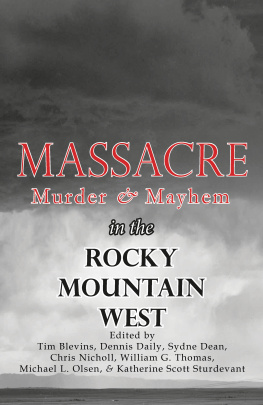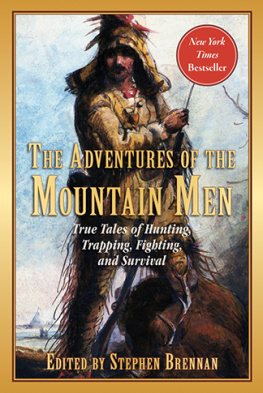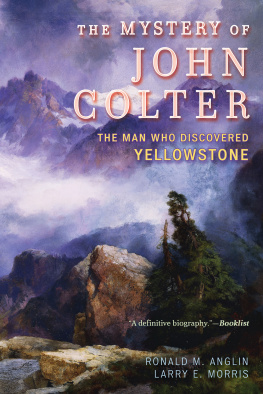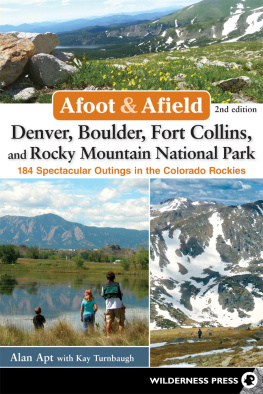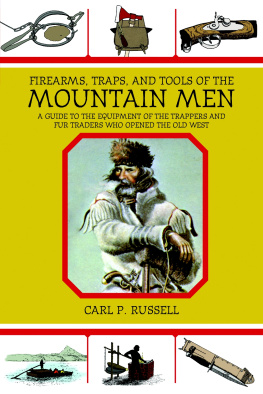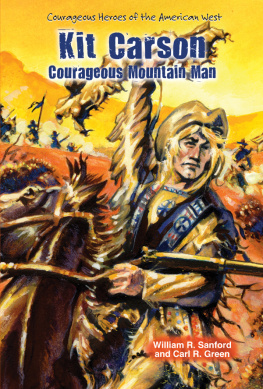
The author and publisher have provided this e-book to you without Digital Rights Management software (DRM) applied so that you can enjoy reading it on your personal devices. This e-book is for your personal use only. You may not print or post this e-book, or make this e-book publicly available in any way. You may not copy, reproduce or upload this e-book, other than to read it on one of your personal devices.
Copyright infringement is against the law. If you believe the copy of this e-book you are reading infringes on the authors copyright, please notify the publisher at: us.macmillanusa.com/piracy .
for Thomas Blevins
I write as though I were speaking directly
to an ideal reader with whom I share basic values .
Because we worked out those values together,
because we are friends more than brothers,
and because, in the day-by-day writing
these words were spoken to your ears,
this book is dedicated to you .
Contents
FIRST INTERLUDE
The Great American Desert
SECOND INTERLUDE
The Trapper and Trapping
THIRD INTERLUDE
Yarning
FOURTH INTERLUDE
Rendezvous
FIFTH INTERLUDE
The BuffaloCuisine Premire
SIXTH INTERLUDE
Mountain Craft
SEVENTH INTERLUDE
Mountain Mating
EIGHTH INTERLUDE
Exploration of the West
NINTH INTERLUDE
Trappers and Indians
APPENDIX A
Chronology of the Fur Trade
APPENDIX B
Glossary
Acknowledgments
I am indebted first to Thomas Blevins, who listened patiently to the thinking through of this book and who read the manuscript and made useful suggestions. Then to Craig Stinson for reading the manuscript perceptively. And to the Henry E. Huntington Library for making its excellent resources available to me.

TALES OF THE HEART: An Introduction to the 40 th Anniversary Edition
For me, this book has been the wildest of roller-coaster rides.
Its conception should have warned me. I was trading stories about the mountain men with a friend at a party in Beverly Hills. A publisher overheard us and was fascinated. Hed never heard of these amazing first men into the West, far ahead of the so-called pioneers. He asked me if I wanted to turn their stories into a book.
What does a young writer do when offered an actual contract to do his first book? I seized the chance with a whoop and a holler.
And then realized I didnt like the way most history was being written. With some exceptions, the authors discussed their characters and doings. They didnt tell the stories as human dramas, with dialogue, action, feelings, the joy of triumphs, and the bitterness of defeats. Instead of telling stories, and giving the readers an experience of what happened, they analyzed and discussed.
For me that was boring. Barren. I didnt want to know about the mountain men intellectually. I wanted to experience their exhilaration at coming into new country, their struggles crossing great rivers during high water, riding across long stretches of waterless plains, marrying Indian women, gradually converting to Indian wayslife as it tasted in the mouth and felt in the chest.
So I approached the tales in this book not as a historian but a storyteller. Sure, I spent months at the Huntington Library to insure accuracy, which is crucial. But facts fall short of truth, because truth includes the yearnings of the human heartfor love, for children, for excitement, for accomplishment, for home. So when I wrote the book, I told stories. No child ever said, Daddy, read me an essay.
Did that approach turn my book into historical fiction? A hybrid like the biographical novel? So be it.
Readers have responded wonderfully. I could not be more grateful that the book has now been in print continuously for forty years. It has gone through five American publishers. Two went bankrupt, and two gave up on the book after many, many sales. Enormous thanks to TOR-Forge for resurrecting it, first as a handsome trade paperback and now in a form not even dreamed of way back in 1973, an e-book.
The men in these stories lived vigorously, daringly, adventurously. I hope readers will ride along with them for decades to come. It is good for the soul.
Win Blevins
Canyon Country,
The first day of spring, 2013.
Introduction
The credit for this books longevityin print for more than thirty years, thanks to my readersbelongs to the men it celebrates, the fellows we call the mountain men. They are our nations half-known, half-regarded, half-scorned heroes.
Their accomplishments were huge. In 1805 the Lewis and Clark men came back. In 1843 the first big migration struck out across the Oregon Trail. In the thirty-eight intervening years, the mountain men roamed the landscape between the Missouri River and the Sierra Nevada. Hundreds of miles from the nearest store, outside the authority of any sheriff, beyond the help of the U.S. cavalry or anyone else back in the States, all the way off the map, they rode, walked, floated, and crawled virtually every inch of the West. They learned the plains down to the last buffalo wallow, the mountains down to the last side canyon, the deserts to the last hidden spring. They lived, hunted, trapped, married, raised children, raised huzzahs to life, and died in the West.
More: They found the trails for their successors to follow. (Frmont, the Pathfinder, was guided by mountain men.) They found out how to survive, and what would get you killed, and handed down the knowledge. In their pitifully small numbers, they learned how to make peace with the Native tribes: A brigade of two dozen men does not march among tens of thousands of Indians looking for a fight.
Unfortunately, the Indian agents and officers of the United States Army did not walk the peaceful path, in Indian relations, that the mountain men had blazed.
Unfortunately again, the mountain men were still in the prime of life when the first wagon trains headed for the paradise of Oregon, or of California. The wagon people looked down their noses at the men in buckskins. Half Injun, they said. Squaw man. Dirty half-breed. So in the 1840s the mountain men gave up and went to farming, or disappeared into Lakota tipis, or deeper into the mountains, and left the settling of the West to their inferiors.
The story of the next half century was sadder, and far bloodier, than it need have been.
My first acquaintance with them came when my great teacher, John G. Neihardt, the author of Black Elk Speaks , told marvelous stories about them. Hugh Glass crawling toward the Missouri River and leaving blood in his hand prints. Jedediah Smith setting out for the Pacific shore with no idea where it was, or what terrible deserts and mountains stood in the way.
Adventure stories, sure. Heroic stories, yes. Stories of the courage of individuals, and at the same time of the bond between men in danger. Ordinary life piddlesthese stories strut.
When I began writing this book, the stories were personal to me. I was spending every possible day climbing mountains. I started on the highest peak in Europe, Mont Blanc, and climbed avidly in the dry mountains of the Mojave Desert, in the grand Sierra Nevada, in the glacial Northwest, in high, cold Colorado, and in the redrock country of the Four Corners.


